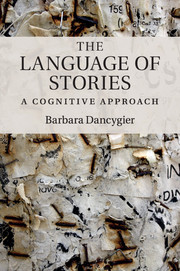Book contents
- Frontmatter
- Contents
- Figures
- Acknowledgements
- Introduction
- 1 Language and literary narratives
- 2 Blending, narrative spaces, and the emergent story
- 3 Stories and their tellers
- 4 Viewpoint
- 5 Referential expressions and narrative spaces
- 6 Fictional minds and embodiment in drama and fiction
- 7 Speech and thought in the narrative
- 8 Stories in the mind
- Notes to the text
- References
- Literary works cited
- Index
6 - Fictional minds and embodiment in drama and fiction
Published online by Cambridge University Press: 05 November 2011
- Frontmatter
- Contents
- Figures
- Acknowledgements
- Introduction
- 1 Language and literary narratives
- 2 Blending, narrative spaces, and the emergent story
- 3 Stories and their tellers
- 4 Viewpoint
- 5 Referential expressions and narrative spaces
- 6 Fictional minds and embodiment in drama and fiction
- 7 Speech and thought in the narrative
- 8 Stories in the mind
- Notes to the text
- References
- Literary works cited
- Index
Summary
O happy dagger! This is thy sheath; there rust and let me die.
(Romeo and Juliet, Shakespeare)In earlier chapters I have focused on the contribution the language of narratives makes to various aspects of story construction. I have relied on cognitive theories of language to reveal the general mechanisms involved, and I tried to link the discussion to broader issues of embodiment, framing, and intersubjectivity. In this chapter I will consider further aspects of embodiment, as represented in the narratives intended for the stage. Specifically, I will look at the linguistic means employed in Early Modern theatre to represent the characters’ minds, and trace some of the subsequent changes in literary style. Overall, I will argue that literature develops its formal means in order to find more accurate ways of representing thoughts and emotions.
Deictic ground in literary discourse
Cognitive grammar and mental spaces theory analysts repeatedly stress the need to include a more refined discussion of the ‘ground’ and the deictic set-up within it. As the discussion in preceding chapters suggests, literary texts pose further challenges to what we understand deictic ground to be. Generally, the ground is claimed to include the presence of the speaker and the hearer, as well as the location of the exchange, its history and goal, and the specific communicative goals of the participants. Recent work (Sanders et al. ) also expands the standard set-up into the ‘Basic Communicative Space Network,’ which assumes not only the presence of the ground, but also epistemic, speech-act, and metalinguistic spaces, ready to be filled with contextually available information on the speaker’s and the hearer’s attitudes and communicative goals.
- Type
- Chapter
- Information
- The Language of StoriesA Cognitive Approach, pp. 139 - 170Publisher: Cambridge University PressPrint publication year: 2011

